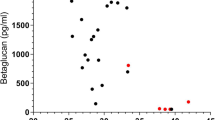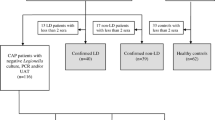Abstract
Legionella pneumophila DNA can be detected in serum from patients with Legionnaires’ disease (LD). We explored this observation studying the kinetics of L. pneumophila DNA in serum samples in relation to C-reactive protein (CRP). Eleven hospitalized patients with LD were studied. Diagnosis was made by Legionella urinary antigen test in 8 patients and seroconversion in 3 patients. A macrophage infectivity potentiator (MIP) real-time PCR was performed on 31 serum samples, including 20 follow-up serum samples. Serum samples obtained on the day of admission were MIP PCR-positive in 7 (64%) and MIP PCR-negative in 4 (36%) patients. Three (75%) of the 4 patients with a MIP PCR-negative serum sample on the day of admission became positive during follow-up. Overall, L. pneumophila DNA was detected in serum samples from 10 of the 11 patients (91%). CRP levels in the 7 patients with a positive MIP PCR serum sample on day of admission (499 ± 144 mg/l; median ± SD) were significantly higher than those in the 4 patients with a negative MIP PCR serum sample on the day of admission (244 ± 97 mg/l). No difference in the severity of the disease on the day of admission was found between these patients. The presence of L. pneumophila DNA in serum is a common phenomenon in hospitalized patients with LD, although in some cases it is not yet present on the day of admission. L. pneumophila DNA in serum on the day of admission correlates with high CRP levels, but not with the severity of the disease.


Similar content being viewed by others
References
Mandell B, Bennet JE, Dolin R (2005) Principles and practice of infectious diseases. Churchill Livingstone, New York, p 2711
Lindsay DS, Abraham WH, Findlay W, Christie P, Johnston F, Edwards GF (2004) Laboratory diagnosis of legionnaires’ disease due to Legionella pneumophila serogroup 1: comparison of phenotypic and genotypic methods. J Med Microbiol 53(Pt 3):183–187. doi:10.1099/jmm.0.05464-0
Heath CH, Grove DI, Looke DF (1996) Delay in appropriate therapy of Legionella pneumonia associated with increased mortality. Eur J Clin Microbiol Infect Dis 15(4):286–290. doi:10.1007/BF01695659
Matsiota-Bernard P, Vrioni G, Nauciel C (1997) Use of the polymerase chain reaction for the detection of Legionella pneumophila DNA in serum samples. Clin Infect Dis 25(4):939. doi:10.1086/515548
Diederen BM, de Jong CM, Kluytmans JA, van der Zee A, Peeters MF (2006) Detection and quantification of Legionella pneumophila DNA in serum: case reports and review of the literature. J Med Microbiol 55(Pt 5):639–642. doi:10.1099/jmm.0.46453-0
Murdoch DR, Walford EJ, Jennings LC, Light GJ, Schousboe MI, Chereshsky AY et al (1996) Use of the polymerase chain reaction to detect Legionella DNA in urine and serum samples from patients with pneumonia. Clin Infect Dis 23(3):475–480
Gabay C, Kushner I (1999) Acute-phase proteins and other systemic responses to inflammation. N Engl J Med 340(6):448–454. doi:10.1056/NEJM199902113400607
Van der Meer V, Neven AK, van den Broek PJ, Assendelft WJ (2005) Diagnostic value of C reactive protein in infections of the lower respiratory tract: systematic review. BMJ 331(7507):26
Garcia Vazquez E, Martinez JA, Mensa J, Sanchez F, Marcos MA, de Roux A et al (2003) C-reactive protein levels in community-acquired pneumonia. Eur Respir J 21(4):702–705
Marnell L, Mold C, Du Clos TW (2005) C-reactive protein: ligands, receptors and role in inflammation. Clin Immunol 117(2):104–111. doi:10.1016/j.clim.2005.08.004
Bangsborg JM, Cianciotto NP, Hindersson P (1991) Nucleotide sequence analysis of the Legionella micdadei mip gene, encoding a 30-kilodalton analog of the Legionella pneumophila Mip protein. Infect Immun 59(10):3836–3840
Cianciotto NP, Fields BS (1992) Legionella pneumophila mip gene potentiates intracellular infection of protozoa and human macrophages. Proc Natl Acad Sci USA 89(11):5188–5191. doi:10.1073/pnas.89.11.5188
Ratcliff RM, Donnellan SC, Lanser JA, Manning PA, Heuzenroeder MW (1997) Interspecies sequence differences in the Mip protein from the genus Legionella: implications for function and evolutionary relatedness. Mol Microbiol 25(6):1149–1158. doi:10.1046/j.1365-2958.1997.5471908.x
Van Doornum GJ, Guldemeester J, Osterhaus AD, Niesters HG (2003) Diagnosing herpesvirus infections by real-time amplification and rapid culture. J Clin Microbiol 41(2):576–580. doi:10.1128/JCM.41.2.576-580.2003
Capelastegui A, Espana PP, Quintana JM, Areitio I, Gorordo I, Egurrola M et al (2006) Validation of a predictive rule for the management of community-acquired pneumonia. Eur Respir J 27(1):151–157. doi:10.1183/09031936.06.00062505
Van der Mee-Marquet N, Domelier AS, Arnault L, Bloc D, Laudat P, Hartemann P et al (2006) Legionella anisa, a possible indicator of water contamination by Legionella pneumophila. J Clin Microbiol 44(1):56–59. doi:10.1128/JCM.44.1.56-59.2006
Bernander S, Gastrin B, Lofgren S, Olinder-Nielsen AM (1994) Legionella urinary antigen in early disease. Scand J Infect Dis 26(6):777–778. doi:10.3109/00365549409008653
Blazquez RM, Espinosa FJ, Martinez-Toldos CM, Alemany L, Garcia-Orenes MC, Segovia M (2005) Sensitivity of urinary antigen test in relation to clinical severity in a large outbreak of Legionella pneumonia in Spain. Eur J Clin Microbiol Infect Dis 24(7):488–491. doi:10.1007/s10096-005-1361-3
Yzerman EP, den Boer JW, Lettinga KD, Schellekens J, Dankert J, Peeters M (2002) Sensitivity of three urinary antigen tests associated with clinical severity in a large outbreak of Legionnaires’ disease in The Netherlands. J Clin Microbiol 40(9):3232–3236. doi:10.1128/JCM.40.9.3232-3236.2002
Diederen BM, Bruin JP, den Boer JW, Peeters MF, Yzerman EP (2007) Sensitivity of Legionella pneumophila DNA detection in serum samples in relation to disease severity. J Med Microbiol 56(Pt 9):1255. doi:10.1099/jmm.0.47258-0
Lorente ML, Falguera M, Nogues A, Gonzalez AR, Merino MT, Caballero MR (2000) Diagnosis of pneumococcal pneumonia by polymerase chain reaction (PCR) in whole blood: a prospective clinical study. Thorax 55(2):133–137. doi:10.1136/thorax.55.2.133
Murdoch DR, Laing RT, Mills GD, Karalus NC, Town GI, Mirrett S et al (2001) Evaluation of a rapid immunochromatographic test for detection of Streptococcus pneumoniae antigen in urine samples from adults with community-acquired pneumonia. J Clin Microbiol 39(10):3495–3498. doi:10.1128/JCM.39.10.3495-3498.2001
Almirall J, Bolibar I, Toran P, Pera G, Boquet X, Balanzo X et al (2004) Contribution of C-reactive protein to the diagnosis and assessment of severity of community-acquired pneumonia. Chest 125(4):1335–1342. doi:10.1378/chest.125.4.1335
Acknowledgements
We thank Kim van der Zwaluw of the National Institute of Public Health and the Environment (RIVM), Bilthoven, The Netherlands, and Erik van Hannen, St. Antonius Ziekenhuis, Nieuwegein, the Netherlands, for DNA obtained from the Legionella strains. We thank Gabriella Morroy from the Municipal Health Service “Hart voor Brabant", ’s Hertogenbosch, The Netherlands for epidemiological assistance.
Conflicts of interest
None.
Author information
Authors and Affiliations
Corresponding author
Rights and permissions
About this article
Cite this article
van de Veerdonk, F.L., de Jager, C.P.C., Schellekens, J.J.A. et al. Legionella pneumophila DNA in serum samples during Legionnaires’ disease in relation to C-reactive protein levels. Eur J Clin Microbiol Infect Dis 28, 371–376 (2009). https://doi.org/10.1007/s10096-008-0638-8
Received:
Accepted:
Published:
Issue Date:
DOI: https://doi.org/10.1007/s10096-008-0638-8




